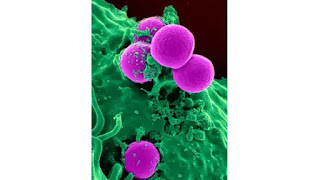Bacteria
Bacteria are microscopic single-celled organisms that thrive in diverse environments. They can live within soil, in the ocean and inside the human gut. Humans' relationship with bacteria is complex. Sometimes they lend a helping hand, by curdling milk into yogurt, or helping with our digestion. At other times they are destructive, causing diseases like pneumonia and MRSA.
Structure
Based on the relative complexity of their cells, all living organisms are broadly classified as either prokaryotes or eukaryotes.
Bacteria are prokaryotes. The entire organism consists of a single cell with a simple internal structure. Unlike eukaryotic DNA, which is neatly packed into a cellular compartment called the nucleus, bacterial DNA floats free, in a twisted thread-like mass called the nucleoid.
Bacterial cells also contain separate, circular pieces of DNA called plasmids. Bacteria lack membrane-bound organelles , specialized cellular structures that are designed to execute a range of cellular functions from energy production to the transport of proteins. However, both bacterial and eukaryotic cells contain ribosomes. These spherical units are where proteins are assembled from individual amino acids, using the information encoded in a strand of messenger RNA
Classification
A few different criteria are used to classify bacteria. They can be distinguished by the nature of their cell walls, by their shape, or by differences in their genetic makeup.
The Gram stain is a test used to identify bacteria by the composition of their cell walls. It is named for Hans Christian Gram, who developed the technique in 1884. Bacteria are first stained with a purple dye called crystal violet, which specifically binds to peptidoglycan, a complex structure of amino acids and sugars found in the cell wall. This is followed by a series of steps that ultimately remove any unbound or loosely bound crystal violet.
Then the cells are stained with a second red-colored dye called safranin. Gram-positive bacteria stain purple because their cell walls are rich in peptidoglycan. On the other hand, Gram-negative bacteria whose cells walls have two layers take on a red coloring. The outer layer of lipids does not bind strongly to crystal violet and the dye is easily washed away during the staining process. For example, Streptococcus pneumoniae, which causes pneumonia, is a Gram-positive bacterium, while Escherichia coli (E.coli) and Vibrio cholerae, which causes cholera, are Gram-negative bacteria.
There are three basic bacterial shapes, according to "Mims Medical Microbiology." Round bacteria are referred to as cocci (singular: coccus); cylindrical, capsule-shaped bacteria as bacilli (singular: bacillus); and spiral bacteria are aptly called spirilla (singular: spirillum). Cocci can also associate with one anothe n different configurations: combinations of two or diplococcus; a linear chain or streptococcus; and a cluster or staphylococcus. The shapes and configurations of bacteria are often reflected in their names. For example, the milk-curdling Lactobacillus acidophilus are bacilli, and pneumonia-causing Streptococcus pneumoniae are a chain of cocci.
The classification criteria mentioned thus far are based on physiological properties and morphology. However, classification of bacteria based on their evolutionary relationships to one another, that is to say, drawing a sort of family tree of all bacterial species, is a relatively new development. This type of phylogeneticclassification became possible with the advent of nucleotide sequencing technology (the ability to read the order of nucleotides in DNA or RNA). Since ribosomes are present in all living organisms, one can look at similarities and differences in the RNA sequences that encode certain ribosomal proteins and determine the degree of relatedness of different organisms
Bacteria in human health and disease
Bacteria can be beneficial as well as detrimental to human health. Commensal bacteria, which share space and resources within our bodies, tend to be helpful. In a 2012 article in the journal Nature, titled "Learning About Who We Are," David A. Relman, a microbiologist at Stanford University, states that there are about 10 times more microbial cells than human cells in the human body. The highest numbers of microbial species are found in the gut.
The human gut is a comfortable setting for bacteria, with plenty of nutrients available for their sustenance. In a 2014 review article, "Analyzing the Human Microbiome: A 'How To' Guide for Physicians," in the American Journal of Gastroenterology, the authors mention that gut bacteria and other microorganisms aid in digestion, stave off colonization by harmful pathogens, and help in the development of the immune system. Moreover, the disruption of gut bacteria has been linked to certain disease conditions. For instance, patients with Crohn's disease have increased antibodies against their gut bacteria and their T-cells are quite aggressive toward bacterial antigens, according to the authors of "Gut Flora Health and Disease," published in The Lancet journal in 2003.
Other bacteria can cause infections. For example, Streptococcus pneumoniae causes pneumonia. Several bacteria ranging from group A Streptococcus, Clostridium, Escherichia coli and Staphylococcus aureuscan cause a rare but severe soft tissue infection called necrotizing fasciitissometimes called "flesh-eating bacteria." According to the Centers for Disease Control, this infection affects the tissues surrounding muscles, nerves, fat, and blood vessels but it can be treated, especially when caught early.


Comments
Post a Comment